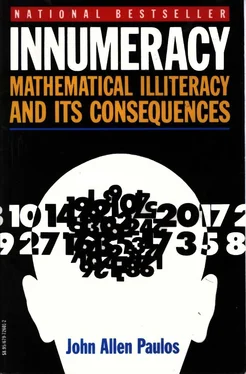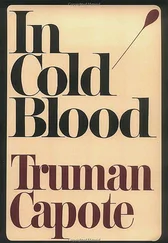John Paulos - INNUMERACY - Mathematical Illiteracy and Its Consequences
Здесь есть возможность читать онлайн «John Paulos - INNUMERACY - Mathematical Illiteracy and Its Consequences» весь текст электронной книги совершенно бесплатно (целиком полную версию без сокращений). В некоторых случаях можно слушать аудио, скачать через торрент в формате fb2 и присутствует краткое содержание. Жанр: Математика, Математика, на английском языке. Описание произведения, (предисловие) а так же отзывы посетителей доступны на портале библиотеки ЛибКат.
- Название:INNUMERACY: Mathematical Illiteracy and Its Consequences
- Автор:
- Жанр:
- Год:неизвестен
- ISBN:нет данных
- Рейтинг книги:5 / 5. Голосов: 1
-
Избранное:Добавить в избранное
- Отзывы:
-
Ваша оценка:
- 100
- 1
- 2
- 3
- 4
- 5
INNUMERACY: Mathematical Illiteracy and Its Consequences: краткое содержание, описание и аннотация
Предлагаем к чтению аннотацию, описание, краткое содержание или предисловие (зависит от того, что написал сам автор книги «INNUMERACY: Mathematical Illiteracy and Its Consequences»). Если вы не нашли необходимую информацию о книге — напишите в комментариях, мы постараемся отыскать её.
Topics include probability and coincidence, the birthday problem, innumeracy in pseudoscience, and statistics and trade-offs in society.
INNUMERACY: Mathematical Illiteracy and Its Consequences — читать онлайн бесплатно полную книгу (весь текст) целиком
Ниже представлен текст книги, разбитый по страницам. Система сохранения места последней прочитанной страницы, позволяет с удобством читать онлайн бесплатно книгу «INNUMERACY: Mathematical Illiteracy and Its Consequences», без необходимости каждый раз заново искать на чём Вы остановились. Поставьте закладку, и сможете в любой момент перейти на страницу, на которой закончили чтение.
Интервал:
Закладка:
From a jar of fleas before him, the celebrated experimenter Van Dumholtz carefully removes a single flea, gently pulls off its back legs, and in a loud voice commands it to jump. He notes that it doesn't move and tries the same thing with a different flea. When he's finished, he compiles statistics and concludes confidently that a flea's ears are in its back legs. Absurd perhaps, but variants of this explanation in less transparent contexts might carry considerable force for people with strong enough preconceptions. Is the explanation any more absurd than that accepted by those who believe the woman who maintains that she is the channel through which a 35,000-year-old man expresses himself? Is it more strained than claims that the skepticism of onlookers systematically prevents the occurrence of certain paranormal phenomena?
What's wrong with the following not quite impeccable logic? We know that 36 inches = 1 yard. Therefore, 9 inches = 1/ 4of a yard. Since the square root of 9 is 3 and the square root of 1/ 4is 1/ 2 , we conclude that 3 inches = 1/ 2yard!
Disproving a claim that something exists is often quite difficult, and this difficulty is often mistaken for evidence that the claim is true. Pat Robertson, the former television evangelist and Presidential candidate, maintained recently that he couldn't prove that there weren't Soviet missile sites in Cuba and therefore there might be. He's right, of course, but neither can I prove that Big Foot doesn't own a small plot of land outside Havana. New Agers make all sorts of existence assertions: that ESP exists, that there have been instances of spoon bending, that spirits abound, that there are aliens among us, etc. Presented as I periodically am with these and other fantastical claims, I sometimes feel a little like a formally dressed teetotaler at a drunken orgy for reiterating that not being able to conclusively refute the claims does not constitute evidence for them.
Many more vignettes illustrating this and other simple logical errors might be cited, but the point is clear enough: both innumeracy and defective logic provide a fertile soil for the growth of pseudoscience. Why both are so widespread is the topic of the next chapter.
4 Whence Innumeracy?
Recent personal experience at a suburban fast-food restaurant: My order of a hamburger, French fries, and a Coke comes to $2.01, and the cashier, who's worked there for months at least, fumbles with the 6 percent tax chart at the side of the cash register, searching for the line that says $2.01-$.12. Accommodating their innumerate help, the larger franchises now have cash registers which have pictures, on the keys, of the items ordered and automatically add on the appropriate tax.
A study indicates that whether or not a department has a mathematics or a statistics requirement is the most important single determinant of where a woman will attend graduate school to study political science.
When I heard the learn'd astronomer where he lectured with much applause in the lecture-room / How soon unaccountable I became tired and sick.
– Walt Whitman
REMEMBRANCE OF INNUMERACIES PAST
Why is innumeracy so widespread even among otherwise educated people? The reasons, to be a little simplistic, are poor education, psychological blocks, and romantic misconceptions about the nature of mathematics. My own case was the exception that proves the rule. The earliest memory I have of wanting to be a mathematician was at age ten, when I calculated that a certain relief pitcher for the then Milwaukee Braves had an earned run average (ERA) of 135. (For baseball fans: He allowed five runs to score and retired only one batter.) Impressed by this extraordinarily bad ERA, I diffidently informed my teacher, who told me to explain the fact to my class. Being quite shy, I did so with a quavering voice and a reddened face. When I finished, he announced that I was all wrong and that I should sit down. ERAs, he asserted authoritatively, could never be higher than 27.
At the end of the season, The Milwaukee Journal published the averages of all Major League players, and since this pitcher hadn't played again, his ERA was 135, as I had calculated. I remember thinking of mathematics as a kind of omnipotent protector. You could prove things to people and they would have to believe you whether they liked you or not. So, still smarting from my perceived humiliation, I brought in the paper to show the teacher. He gave me a dirty look and again told me to sit down. His idea of a good education apparently was to make sure everyone remained seated.
Though not dominated by martinets like my teacher, early mathematics education is generally poor. Elementary schools by and large do manage to teach the basic algorithms for multiplication and division, addition and subtraction, as well as methods for handling fractions, decimals, and percentages. Unfortunately, they don't do as effective a job in teaching when to add or subtract, when to multiply or divide, or how to convert from fractions to decimals or percentages. Seldom are arithmetic problems integrated into other schoolwork-how much, how far, how old, how many. Older students fear word problems in part because they have not been asked to find solutions to such quantitative questions at the elementary level.
Although few students get past elementary school without knowing their arithmetic tables, many do pass through without understanding that if one drives at 35 m.p.h. for four hours, one will have driven 140 miles; that if peanuts cost 40 cents an ounce and a bag of them costs $2.20, then there are 5.5 ounces of peanuts in the bag; that if 1/ 4of the world's population is Chinese and 1/ 5of the remainder is Indian, then 3/ 20or 15 percent of the world is Indian. This sort of understanding is, of course, not the same as simply knowing that 35 x 4 = 140; that (2.2)/(.4) = 5.5; that 1/ 5x (1 – 1/ 4) = 3/ 20=.15 = 15 percent. And since it doesn't come naturally to many elementary students, it must be furthered by doing numerous problems, some practical, some more fanciful.
Estimation is generally not taught either, aside from a few lessons on rounding off numbers. The connection is rarely made that rounding off and making reasonable estimates have something to do with real life. Grade-school students aren't invited to estimate the number of bricks in the side of a school wall, or how fast the class speedster runs, or the percentage of students with bald fathers, or the ratio of one's head's circumference to one's height, or how many nickels are necessary to make a tower equal in height to the Empire State Building, or whether all those nickels would fit in their classroom.
Almost never is inductive reasoning taught or are mathematical phenomena studied with an eye toward guessing the relevant properties and rules. A discussion of informal logic is as common in elementary mathematics courses as is a discussion of Icelandic sagas. Puzzles, games, and riddles aren't discussed-in many cases, I'm convinced, because it's too easy for bright ten-year-olds to best their teachers. The intimate relationship between mathematics and such games has been explored most engagingly by mathematics writer Martin Gardner, whose many charming books and Scientific American columns would make exciting outside reading for high school or college students (were they but assigned), as might mathematician George Polya's How to Solve It or Mathematics and Plausible Reading. A delightful book with something of the flavor of these others, but at an elementary level, is I Hate Mathematics by Marilyn Burns. It's full of what elementary math textbooks rarely have-heuristic tips on problem solving and whimsy.
Instead, too many textbooks still list names and terms, with few if any illustrations. They note, for example, that addition is said to be an associative operation since (a + b) + c = a + (b + c). Seldom is any mention made of an operation which is non-associative, so the definition seems unnecessary at best. In any case, what can you do with this piece of information? Other terms seem to be introduced with no rationale other than that they look impressive when printed in boldface type inside a little box in the middle of the page. They satisfy many people's conception of knowledge as a kind of general botany where there's a place for everything and everything has its place. Mathematics as a useful tool or as a way of thinking or as a source of pleasure is a notion quite foreign to most elementary-education curricula (even to those whose textbooks are adequate).
Читать дальшеИнтервал:
Закладка:
Похожие книги на «INNUMERACY: Mathematical Illiteracy and Its Consequences»
Представляем Вашему вниманию похожие книги на «INNUMERACY: Mathematical Illiteracy and Its Consequences» списком для выбора. Мы отобрали схожую по названию и смыслу литературу в надежде предоставить читателям больше вариантов отыскать новые, интересные, ещё непрочитанные произведения.
Обсуждение, отзывы о книге «INNUMERACY: Mathematical Illiteracy and Its Consequences» и просто собственные мнения читателей. Оставьте ваши комментарии, напишите, что Вы думаете о произведении, его смысле или главных героях. Укажите что конкретно понравилось, а что нет, и почему Вы так считаете.












